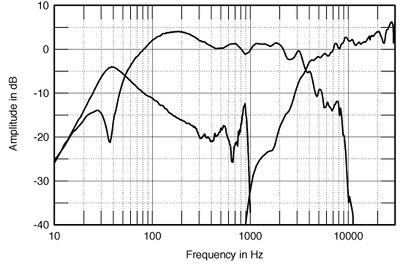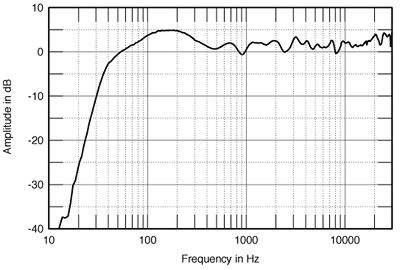| Columns Retired Columns & Blogs |
B&W Compact Domestic Monitor 1 loudspeaker Measurements
Sidebar 3: Measurements
I estimated the CDM 1's B-weighted sensitivity to be around 86dB/2.83V/m, a typical figure for a smallish speaker. Its impedance traces (fig.1) revealed it to be a relatively undemanding load for an amplifier, with minimum values around 5 ohms in the lower midrange and high treble. The reflex port tuning is indicated by the "saddle" in the magnitude trace at 40Hz. Note the slight glitch in both magnitude and phase traces between 900Hz and 1kHz, this a clue to the presence of some kind of resonance.

Fig.1 B&W CDM 1, electrical impedance (solid) and phase (dashed) (2 ohms/vertical div.).
The individual drive-unit and port responses are shown in fig.2. The port's output is centered in the 40Hz region but features a spike of energy at 900Hz, this coincident with a small suckout in the woofer's output at the same frequency and probably correlated with the impedance anomaly noted above. The woofer's nearfield output is a little exaggerated in the upper bass—something the CDM 1 has in common with the Silver Signature—and its farfield output rolls off relatively smoothly above 3kHz. The actual crossover to the tweeter appears to lie a little higher than specified, at 3.7kHz. The tweeter's on-axis passband response gently rises with frequency, but is smooth overall.

Fig.2 B&W CDM 1, acoustic crossover on tweeter axis at 50", corrected for microphone response, with nearfield woofer and port responses plotted below 300Hz.
The B&W's overall response, averaged across a 30 degrees lateral window on the tweeter axis, is shown in fig.3 and is superbly flat throughout the upper midrange and treble. No wonder this speaker sounded uncolored! The upper bass can be seen to be a little generously balanced; however, as a result, the -6dB point with respect to the 1kHz reference level lies at a low 35Hz.

Fig.3 B&W CDM 1, anechoic response on tweeter axis at 50", averaged across 30 degrees horizontal window and corrected for microphone response, with complex sum of nearfield woofer and port responses plotted below 300Hz.
Laterally (fig.4), the CDM 1 shows textbook dispersion, the top two octaves rolling off gently and uniformly with increasing off-axis angle and the off-axis restriction in the woofer's output at the top of its passband kept to a minimum. This behavior correlates well with the excellent perceived soundstaging. Vertically (fig.5), crossover-region suckouts appear if you sit with your ears below the tweeter axis or more than 10 degrees above it. Be careful not to put the CDM 1 on too high a stand. In-room, the B&W's spatially averaged 1/3-octave response (fig.6) was superbly flat, with useful bass available down to the 31.5Hz band.

Fig.4 B&W CDM 1, horizontal response family at 50", normalized to response on tweeter axis, from back to front: differences in response 90 degrees-5 degrees off-axis; reference response; differences in response 5 degrees-90 degrees off-axis.

Fig.5 B&W CDM 1, vertical response family at 50", normalized to response on tweeter axis, from back to front: differences in response 90 degrees-5 degrees above tweeter axis; reference response; differences in response 5 degrees-90 degrees below tweeter axis.

Fig.6 B&W CDM 1, spatially averaged 1/3-octave response in JA's room.
- Log in or register to post comments




































